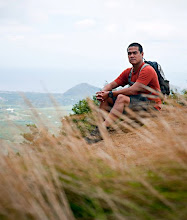The trailhead for Laie Falls is located across the road from the Laie Mormon Temple. If you are coming from the North Shore, and you pass Laie Shopping Center, you've gone too far; if you are coming from Kaneohe, and you pass Hukilau Beach Park, you've gone too far. Drive down the road. A yellow, open gate comes in to view. The side of the street offers parking. Walk down a paved road until it terminates to dirt. Ignore side roads along the way until another gate comes into view with signs indicating the start of the Laie Falls Trail. From there the trail is very easy to follow, and if one does become hesitant about side trails on the left and right, pink ribbons will direct the path correctly.
Soon after, the trail gradually ascends up long and hot eroded sections. Hiking these eroded sections in the summer would definitely be uncomfortable. The trail does offer some shade at times in between the eroded sections. Shade becomes more abundant once the trail cuts through a beautiful section of Cook pines. From the Cook pines and beyond, there aren't any eroded sections. After the pines, a long section of the trail contours the left side of the ridge, first passing uluhe ferns and then passing a long, dark, tunneled stretch of strawberry guava trees. This section of the trail does get monotonous, taking around half-an-hour to reach the junction that descends to Laie Falls. The junction is welcoming sight.
The Laie Trail is actually a graded ridge trail to the Ko'olau Summit, eventually reaching the junction with the Ko'olau Summit Trail. From the waterfall the junction, the trail continues straight to the summit. The trail to the summit from the trailhead is about six miles, making the trek to the summit a round trip of about twelve miles. The trail to Laie Falls is probably around two-and-a-half to three miles. It's not overly exerting, making for a great family hike, but the semi-steep trail to the falls does require some caution because some parts require minor scrambling with the aid of a rope or two.
Laie Falls is a two tiered waterfall, the higher one being the largest at around fifteen feet. A pool at the bottom of the higher waterfall offers a cool, refreshing, sweat-cleansing dip after an hour-and-a-half of hiking. In addition, the surrounding area is a quiet and peaceful lunching spot, accompanied by soft breezes. There is a trail that leads up to the top of the highest waterfall, and I'm pretty sure progress upstream is possible by following the trail. If one goes far enough, there may be another waterfall, but don’t take my word for it.
We headed out from the falls around 4:00pm, eventually reaching our car at 5:15pm. The hike back was pleasant; the cool wind kept us dry, and the sun was setting behind us, eventually dipping below and behind the Ko’olau Mountain Range. Picturesque views from Malaekahana to Laie Point lay out in front of us, with views of Malaekahana Ridge to the left, and another lush ridge to the right. Laie Falls is definitely a trail I will do again, and the summit hike is one I look forward to as well.

 Two ribbons on hikes means a significant junction along a trail. Here is Matt, standing in the trail that leads to the waterfall. Continuing straight tops out at the Ko'olau summit.
Two ribbons on hikes means a significant junction along a trail. Here is Matt, standing in the trail that leads to the waterfall. Continuing straight tops out at the Ko'olau summit.


























































